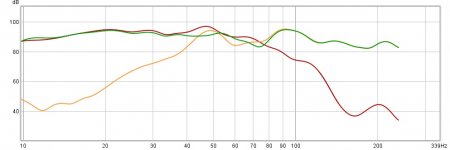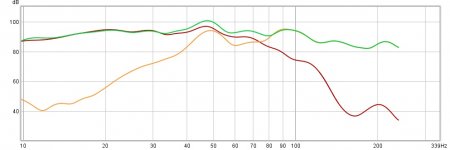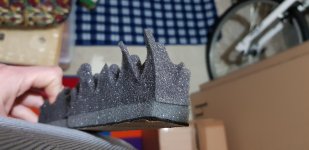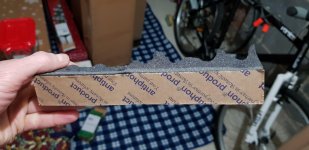I don't believe that there will be any effect with those, in the passband used. Think about wavelength...
dB v2
Measurements will tell!
Thanks, interesting article.
The main reason for me wanting to fit some is to reduce audible sound above the passband to prevent these higher frequencies muddying the passband of the main full range speakers. I've successfully reduced these by adding another 30dB octave LPF at 120Hz. This is in addition to the av amps 24dB 60Hz LPF for the sub and 12dB 60Hz HPF on the mains. My logic is that I'm allowing a smooth blended crossover at 60Hz but then brickwalling the sub at 120Hz.
But I'm still curious about reducing some of the internal reflections, to prevent these bleeding through the drivers and/or the port, which if at all audible will be noise.
Cheers
Managed to perform phase alignment using mic and REW. Before and after response attached. Red is sub. Orange is Mains, Green is total.
Before graph shows almost totally out of phase, lots of destructive summation
After response shows my best attempt down to the closest 0.1ms at constructive summation. Sounds much better now this is corrected.
Thanks to this link - https://www.avsforum.com/forum/155-...-subwoofers-mains-integration-how-thread.html
Before graph shows almost totally out of phase, lots of destructive summation
After response shows my best attempt down to the closest 0.1ms at constructive summation. Sounds much better now this is corrected.
Thanks to this link - https://www.avsforum.com/forum/155-...-subwoofers-mains-integration-how-thread.html
Attachments
Hi all, below is a detailed before and after assessment with measurements of the application of acoustic lining to this design. Any questions, please let me know. I hope this post is of interest.
Some of the issues I’ve had with the enclosure –
I’ve long suspected the enclosure sounds hollow. It sounds like echoing - albeit heavily attenuated and short lived echoing, which colours the sound.
Upper bass and midrange being emitted allows the sub to be located. I’ve always believed this is due to reflections and/or ringing bleeding through the drivers/port. Note: the enclosure is fairly substantial (1 inch thick with 2 Inch front baffle) and braced relatively well.
It has a howling sound emitting from it. Only audible when putting your ears up to the enclosure and playing low frequencies loudly (20Hz for example). I believe this is due to the movement of air around and over the smooth internals of the enclosure.
A cabinet buzzing noise from 310Hz to 360Hz when doing frequency sweeps with no LPF.
Spikey frequency response outside of passband. The first notable spike is due to the port resonance @ 132Hz and in room produces a measurable spike at 111Hz.
For the above reasons I decided to fit some lining to the internal walls of the enclosure. I spent a lot of time researching and opted for a foam type material. The acoustic material has a peel and stick backing with 1.5mm of bitumen, 1 cm of foam (I believe closed cell) and 25mm of egg crate open cell foam -Total height of 35mm. The dimensional resonances of the enclosure are at 201Hz, 381Hz, 527Hz and 623Hz with the port resonance being 132Hz. The Height dimensional resonance at approx. 200Hz and the port resonance at 132Hz are the greatest concerns being closest to the pass band of the sub. 0.3square meters (3.3 square foot) of foam lining was applied as per last image, which was strategically placed to reduce the 201Hz, 381Hz and 527Hz resonance/ringing. No damping applied on the side walls (623Hz) and no damping applied at the internal mouth of the port (132Hz). I was hoping the combination of closed and open cell foam offset each other to have no impact on the apparent volume seen by the drivers (where open cell foam effectively increases the volume seen by the drviers and both closed cell foam and bitumen reduce the volume).
I took 4 before and after measurements as follows –
Listening position – on sofa. Barely any noticeable difference, apart from slightly flatter response in mid range, and 200Hz peak being cut.
Nearfield - 15cm from top driver. No noticeable difference
Port – directly at opening. Issue caused by 200Hz ringing is drastically improved, no change to port resonance as expected.
Internal – one driver removed and one left operating. Mic placed inside the box and the driver hole covered with a pillow. Checkout how much the upper frequencies have been reduced, especially the 200Hz resonance/ringing issue !!!!! This waterfall graph says it all !!!!!!!! (This measurement was only possible due to my sub having two drivers, otherwise I’d have never got the mic in for measuring)
What has been achieved/lost by lining –
- Hollow sound has been drastically improved and the sub is now a lot harder to locate, presumably due to suppression of resonance/ringing at upper bass / mid range frequencies.
- Generally sounds a lot better, I can now barely tell when the sub is on. The only give away now is when the source content has low frequency content and you know the sub must be on because the mains can’t go that low !!!! eg The way it should be !!
- The cabinet buzz at 310-360Hz is no longer present
- Howling sound greatly reduced, although this was never really a problem anyway.
- Slight loss of efficiency (1dB) at around 30Hz
Conclusion
Unless you are going for all out efficiency, put some lining in your bass reflex subs. I’ve noticed a huge difference in sound quality. I was hesitant to put foam in , given lots of conflicting views on forums, but after a lot of research I chose foam because I only wanted to reduce reflections and ringing outside of the passband of the sub. This stuff has worked a treat for me, and it’s effects are clearly audible and visible in the measurements, especially in the internal measurement which proves the impact of the lining in exactly the place the lining is supposed to have an impact (inside the enclosure). The noise caused by reflections and ringing inside the enclosure bleeding through the driver / port, will negatively contribute to the sound quality of the sub, and due to them not being as loud as the sound being produced by the driver/port directly, will not necessarily be picked up in measurements at the listening position. They will only be noticeable in the form of muddying / colouring the sound, in my case outside of my subs passband and degrading the sound from my mains. In my next design, I will apply this type of foam on all the internal surfaces and line the internal port mouth with poly wadding sheets to reduce the port resonance.
Some of the issues I’ve had with the enclosure –
I’ve long suspected the enclosure sounds hollow. It sounds like echoing - albeit heavily attenuated and short lived echoing, which colours the sound.
Upper bass and midrange being emitted allows the sub to be located. I’ve always believed this is due to reflections and/or ringing bleeding through the drivers/port. Note: the enclosure is fairly substantial (1 inch thick with 2 Inch front baffle) and braced relatively well.
It has a howling sound emitting from it. Only audible when putting your ears up to the enclosure and playing low frequencies loudly (20Hz for example). I believe this is due to the movement of air around and over the smooth internals of the enclosure.
A cabinet buzzing noise from 310Hz to 360Hz when doing frequency sweeps with no LPF.
Spikey frequency response outside of passband. The first notable spike is due to the port resonance @ 132Hz and in room produces a measurable spike at 111Hz.
For the above reasons I decided to fit some lining to the internal walls of the enclosure. I spent a lot of time researching and opted for a foam type material. The acoustic material has a peel and stick backing with 1.5mm of bitumen, 1 cm of foam (I believe closed cell) and 25mm of egg crate open cell foam -Total height of 35mm. The dimensional resonances of the enclosure are at 201Hz, 381Hz, 527Hz and 623Hz with the port resonance being 132Hz. The Height dimensional resonance at approx. 200Hz and the port resonance at 132Hz are the greatest concerns being closest to the pass band of the sub. 0.3square meters (3.3 square foot) of foam lining was applied as per last image, which was strategically placed to reduce the 201Hz, 381Hz and 527Hz resonance/ringing. No damping applied on the side walls (623Hz) and no damping applied at the internal mouth of the port (132Hz). I was hoping the combination of closed and open cell foam offset each other to have no impact on the apparent volume seen by the drivers (where open cell foam effectively increases the volume seen by the drviers and both closed cell foam and bitumen reduce the volume).
I took 4 before and after measurements as follows –
Listening position – on sofa. Barely any noticeable difference, apart from slightly flatter response in mid range, and 200Hz peak being cut.
Nearfield - 15cm from top driver. No noticeable difference
Port – directly at opening. Issue caused by 200Hz ringing is drastically improved, no change to port resonance as expected.
Internal – one driver removed and one left operating. Mic placed inside the box and the driver hole covered with a pillow. Checkout how much the upper frequencies have been reduced, especially the 200Hz resonance/ringing issue !!!!! This waterfall graph says it all !!!!!!!! (This measurement was only possible due to my sub having two drivers, otherwise I’d have never got the mic in for measuring)
What has been achieved/lost by lining –
- Hollow sound has been drastically improved and the sub is now a lot harder to locate, presumably due to suppression of resonance/ringing at upper bass / mid range frequencies.
- Generally sounds a lot better, I can now barely tell when the sub is on. The only give away now is when the source content has low frequency content and you know the sub must be on because the mains can’t go that low !!!! eg The way it should be !!
- The cabinet buzz at 310-360Hz is no longer present
- Howling sound greatly reduced, although this was never really a problem anyway.
- Slight loss of efficiency (1dB) at around 30Hz
Conclusion
Unless you are going for all out efficiency, put some lining in your bass reflex subs. I’ve noticed a huge difference in sound quality. I was hesitant to put foam in , given lots of conflicting views on forums, but after a lot of research I chose foam because I only wanted to reduce reflections and ringing outside of the passband of the sub. This stuff has worked a treat for me, and it’s effects are clearly audible and visible in the measurements, especially in the internal measurement which proves the impact of the lining in exactly the place the lining is supposed to have an impact (inside the enclosure). The noise caused by reflections and ringing inside the enclosure bleeding through the driver / port, will negatively contribute to the sound quality of the sub, and due to them not being as loud as the sound being produced by the driver/port directly, will not necessarily be picked up in measurements at the listening position. They will only be noticeable in the form of muddying / colouring the sound, in my case outside of my subs passband and degrading the sound from my mains. In my next design, I will apply this type of foam on all the internal surfaces and line the internal port mouth with poly wadding sheets to reduce the port resonance.
Attachments
-
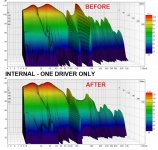 Internal Waterfall Before and After.jpg317.3 KB · Views: 170
Internal Waterfall Before and After.jpg317.3 KB · Views: 170 -
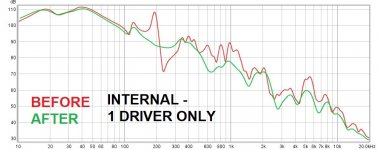 Internal Before and After Damping.jpg100.5 KB · Views: 158
Internal Before and After Damping.jpg100.5 KB · Views: 158 -
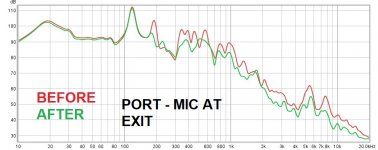 Port Before and After Damping.jpg96.7 KB · Views: 436
Port Before and After Damping.jpg96.7 KB · Views: 436 -
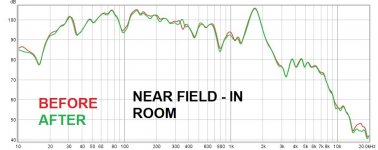 NF Before and After Damping.jpg88.4 KB · Views: 433
NF Before and After Damping.jpg88.4 KB · Views: 433 -
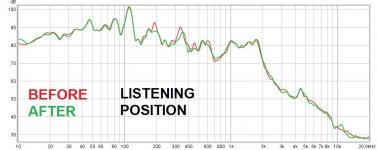 LP Before and After Damping.jpg91.7 KB · Views: 437
LP Before and After Damping.jpg91.7 KB · Views: 437 -
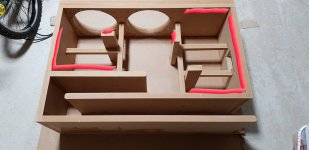 20191216_094343.jpg340.8 KB · Views: 252
20191216_094343.jpg340.8 KB · Views: 252
Last edited:
HAH! I was the first one to like your video.
It is huge! I was under the impression that space was an issue. I dont know why I thought so. Well done on the build.
Maybe with your next build, you could add lengths of mdf cut at 45 deg and place it in the corners of your slot, bottom left the two corners.
It is huge! I was under the impression that space was an issue. I dont know why I thought so. Well done on the build.
Maybe with your next build, you could add lengths of mdf cut at 45 deg and place it in the corners of your slot, bottom left the two corners.
Thanks ! Space was never really an issue, always wanted to go bigger, but realized having built this, that I can't go any bigger, because then it would be a two person build.
Agree on the 45's - didn't have correct tooling in this build. Still happy with it though. Just need better drivers, hence hoping to upgrade to the SEAS one day. The SEAS drivers also have silver cones, so will match the Montior Audio mains nicely
Agree on the 45's - didn't have correct tooling in this build. Still happy with it though. Just need better drivers, hence hoping to upgrade to the SEAS one day. The SEAS drivers also have silver cones, so will match the Montior Audio mains nicely
- Status
- This old topic is closed. If you want to reopen this topic, contact a moderator using the "Report Post" button.
- Home
- Loudspeakers
- Subwoofers
- Project – 2 x Peerless XLS 10” 20Hz tuned slot port subwoofer
